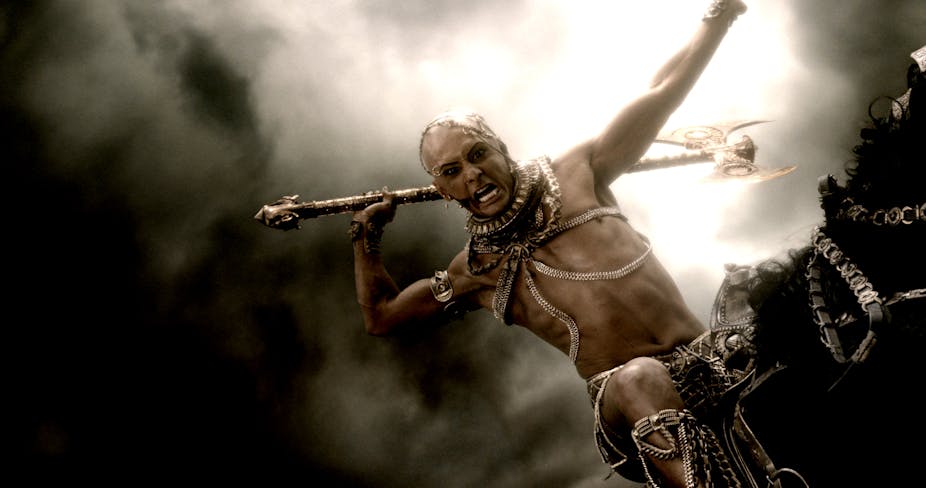Earlier this week, a man who argued about the ending of 300: Rise of an Empire was killed by fellow film-goers in Texas. Though a tragic and solitary event, it puts the recent upsurge in ancient history films centre stage and prompts us to think about their often controversial appeal.
Ever since Ridley Scott’s Gladiator won an emphatic thumbs-up from cinema audiences in 2000, film-makers have repeatedly returned to ancient history and mythology for inspiration. And in the box office’s battles between Achilles and Theseus, Leonidas and Alexander, it is 2007’s 300 that triumphs, enjoying the biggest financial (if not necessarily critical) rewards. What can the most recent 300 film tell us about the ongoing appeal of these ancient narratives?
While 300 told the story of the Persian defeat of Leonidas and his Spartan warriors at the battle of Thermopylae in 480 BCE, the sequel focuses on the sea-battles led by the Athenian general, Themistocles, at Artemisium and Salamis, in the same year. Neither film is particularly concerned to stick to the historical facts, and audiences should not expect too much in terms of authenticity – although the Iranian protests against 300’s depiction of the Persians remind us that ancient history is far from politically irrelevant.
In fact, one of the most interesting features of 300 was its depiction of the process by which a historical event becomes myth – through the telling. We see the soldier Dilios relaying the story to his fellow Spartans, as he urges them to avenge Leonidas and defeat the tyrannical Persians.
Fittingly, 300: Rise of an Empire opens with a striking image of the dead Leonidas and his fallen men. The birds-eye shot that closed the first film now appears as if carved on temple doors: readers of Virgil’s Aeneid might recall the scenes of the Trojan War that decorate the doors of a Carthaginian temple. The 300 films make us think about how, like the great myths of Troy, the Persian Wars become the stuff of epic narrative.

But such subtle readings flatter films that are driven, above all, by spectacular battle sequences, distinctively filmed in a style that recalls computer game graphics. 300: Rise of an Empire revels in violent combat even more than its predecessor did. Literally blood-spattered, the camera lens is hit by slo-mo sprays of blood from deep wounds. Severed limbs litter the screen. With the now inevitable 3D heightening the gruesome spectacle yet further, ancient battles still have much to offer bloodthirsty audiences.
The screen continues to be a modern parallel for the ancient arena, and graphic violence is arguably more acceptable because of its historical distance. Antiquity has long been used as by film-makers as a way of pushing boundaries. When censorship restricted Hollywood’s depiction of sex and violence in the mid-20th century, ancient settings allowed films to titillate and tantalise audiences by offering a taste of the exotic distant past, when different cultural norms held sway.
Something of that same seductive appeal continues to give ancient world movies their charge today. This is perfectly embodied by 300: Rise of an Empire’s villain, Artemisia (played by Eva Green). This Greek-born woman commands Xerxes’ Persian fleet in its battles against Themistocles’s navy (inflating her role from a queen who contributed a few ships to the Persians, in the historical record). Beautiful, powerful, and dangerous, she is in some ways just the latest in a long line of historical femmes fatales that populate ancient world films, from Claudette Colbert’s Poppaea in The Sign of the Cross (1932) to Elizabeth Taylor’s iconic Cleopatra (1963) and beyond.

But this new film and others in recent years do show some attempts to update their gender politics for the 21st century. While the focus remains heavily on battles and military prowess, women have now joined the ranks of the warriors. In 2010’s Centurion, Etain fights the Romans alongside her fellow Picts, while 300: Rise of an Empire puts Artemisia front and centre.
These warrior women are problematic. The mute Etain literally has no voice, while the harlot Artemisia must die at the hands of Themistocles’ phallic sword thrust. But the film does at least offer us the vision of the Spartan Queen Gorgo leading the final Greek battle charge. Ahistorical it may be, but it is reassuring to see Lena Headey’s character storm the ships as an equal and a counterpart to Themistocles.
The latest 300, then, offers the merest glimpse of a new approach to depicting the ancient world, though it treads familiar ground far more than it breaks new. In a cinematic genre which has always been deeply traditional, this should come as no surprise. The question remains, though, as to how long audiences will be satisfied by repetitive, one-dimensional screen versions of antiquity before growing tired of them. With two more such films, Pompeii and Noah, about to be released, we will soon see whether any new life can be breathed into our attempts to recreate the ancient world in the cinema.

